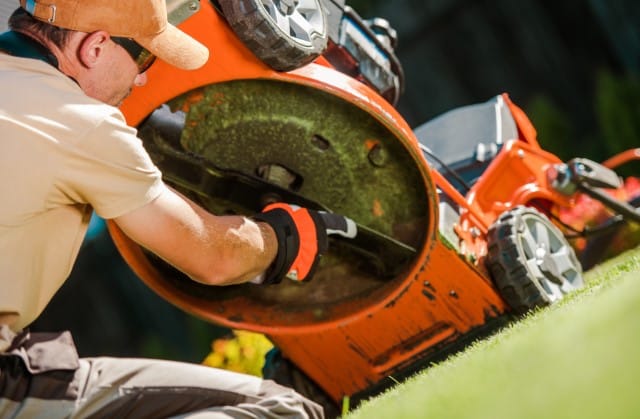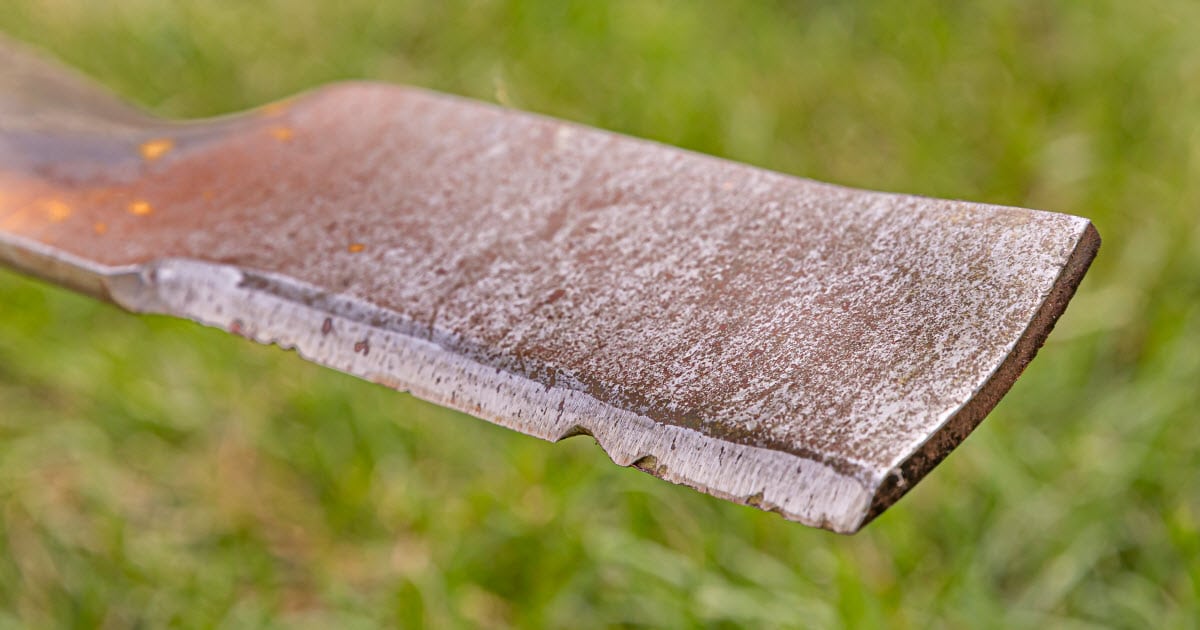As you get your lawn equipment ready for another season, it’s a great time to sharpen your mower blades. We all like to fertilize, water, and edge our lawns, but your lawn mower is the most essential tool in our garage, and whether you use a gas-powered mower, or you’ve gone electric, your mower still uses blades to mow your lawn. That means a regular part of mower maintenance for all of us includes sharpening the blades. In today’s article, I’ll explain how to sharpen lawn mower blades with a file.

This article was last updated on by Lawn Chick Owner Sarah Jameson
Article content reviewed for accuracy by Horticulturist Arthur Davidson, A.S.
Why Sharpen Your Lawn Mower Blades?
It’s important not to overlook your lawn mower’s blades. With time and use, blades get dull and need to be sharpened. Sharp mower blades lead to a clean cut of your grass. This keeps your lawn healthy, and can help it resist disease (which likes to enter through damaged leaves).

Beyond the wear and tear of general mowing, damage can also dull your blades. This can happen when you run over rocks, stones, sticks, pinecones, and other yard debris.
If you’ve heard more than a few clinks along the way, make sure you check and see what kind of damage your blade has been taking.
Damaged blades can also get out of balance. This means that the weight of one side of the blade is higher – making the blade wobble as it spins.
Unbalanced mower blades will cause your mower to run rough, and perform poorly.
| LawnChick.com is reader supported. If you make a purchase after clicking a link, I may earn a commission at no additional cost to you. |
How to Sharpen Your Lawn Mower Blades with a File
The steps I go over here will help you safely and successfully sharpen your mower blades with a file.
Put on Protective Eye Gear and Gloves
Remember to put on protective eye gear and gloves before starting this process.
Disconnect Spark Plugs and Power Sources
To ensure your safety, disconnect spark plugs and any power sources before flipping over your lawnmower and checking the blades.
It’s a step a lot of people skip, but all of the experts recommend this because you must absolutely eliminate any risk that the lawnmower could begin on its own.
Tilt Your Mower Straight Up
Your blades are underneath the mower, so the best way to access them is by tilting the mower. Most people advise you to turn the mower over to one side, which works, but is not ideal.
I like to tilt the mower straight up (with the front up in the air) to avoid gas or oil spills.

If you do tilt your mower on the side, it is important to turn the mower over onto the side with the carburetor and the air filter face up.
These are often on the side of the engine in plastic casing, and noticeably protruding. It’s typically the opposite side from where your mower’s exhaust pipe is located.
Remove the Blades
Make sure you have your sturdy garden or leather gloves on for this step. Once the mower is on its side, away from the carburetor and air filter, use a wrench to undo the blades.
With the gloved hand, grab ahold of the blade and with the other hand remove the nuts that keep the blade connected to the mower.
TIP: Keep a mark on the blades to remember which side is up and which faces down. This will help to keep from replacing the blades the wrong way when you’re all finished.
Clean the Blades
Clean the blades off with a wet rag, wiping off any excess debris. Then repeat this process with a dry rag.
While cleaning, be careful not to scrub off the mark you just made to remember which side faces up.
Fasten the Blades In
To keep each blade stable for sharpening, clamp it on your workstation. A vise or a sturdy clamp will secure the blade.

Before you get to sharpening, lay out some newspaper or an old rag to catch any metal filings. This will make your cleanup much quicker when you’re all finished.
Sharpen the Blades
Again, make sure you have on your gloves and eye protection. They’re especially crucial for your safety during this step.
Sharpen your lawn mower blades with the file. I recommend you keep your angle pretty much the same as the factory edge and angle the blade has. You want to run the file the full length of the blade with even pressure on each pass.
When you finish with the first side, flip the blade and sharpen the other side.
Check for Balance
When you’ve finished sharpening, and achieved the edge you want on each side of your blade you’ll want to check the balance.

Any time you remove some of the metal with a file, there’s a chance you’ve removed more on one side than the other, which can make your blade wobble and perform poorly when you re-attach it.
You can place the blade onto a balancer to check whether the blade is level. Most people invest in a blade balancer like this one on Amazon, but a balancer could be any object narrow enough to balance the blade on at its midpoint like a teeter-totter.
I use a nail I pounded into a post in my garage. After I sharpen my mower blade with my file I just pop the blade on there with the nail through the center hole and the two sides of the blade levelled horizontally. When I let go of the blade it’s obvious if the blade is balanced (it stays in its horizontal position), or if one side is heavier (that side begins to tilt down).
If your sharpened blade is out of balance, don’t sweat it. Just grind down the heavier side a little further and reassess until the blade doesn’t teeter on the balancer.
Reattach the Blade
Before reattaching your mower blade, spray the blade with WD-40 (available on Amazon, at Ace Hardware and other local stores) to reduce the chance of rust.
I also suggest cleaning the underside of your mower deck at this time since your blade is already out of the way.
Next, attach the blade back on your mower. Pay attention to which side of the blade faces up based on the mark you put on it when you removed it earlier.
Bolt the blade in securely.
TIP: In case your mark wore off, or you forgot to mark your blade when you removed it, the sharp edge should face the direction in which the blade spins.
Test Run
Replace the spark plugs and power sources in order to start up the mower for a test run. Make sure everything looks and sounds good.

If you aren’t feeling too comfortable with things, check your blades over and make sure there isn’t an issue with the balance.
Now You Know How to Sharpen Lawn Mower Blades With a File
Remember, if you don’t feel comfortable or safe sharpening your mower blade yourself, bring it to a professional.
Want to learn more about mower blades? Before you go, check out my article revealing whether brand new lawn mower blades need to be sharpened to perform well.










